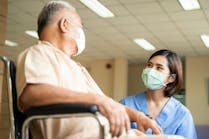Observatory
News/ Trends/ Analysis
By MLO
Unusual blastomycosis activity in Wisconsin. Experts from the Centers for Disease Control and Prevention (CDC) have joined officials from Marathon County, WI, to investigate a blastomycosis outbreak that has sickened 32 people since January, according to a WSAU radio news report. County officials report that the illnesses do not fit the normal profile, and are striking more women and younger people in different geographic clusters. Blastomycosis is a fungal infection spread by inhaling spores of Blastomyces dermatitidis, which can cause a lung infection that also can involve other organ systems. Symptoms can include a dry cough, fever, chest pain, and weight loss. Infected symptomatic individuals usually have abnormalities present on their chest X-rays. These abnormalities, however, are not unique to blastomycosis and may occur with many other respiratory illnesses. The identification of the fungus B dermatitidis in a culture of the sputum, skin, or biopsy specimen of infected tissue can confirm the diagnosis of blastomycosis. Blood specimens may also be used to determine if an individual has had a previous blastomycosis infection; however, blood tests will not identify all cases and on occasion may be false positive. Skin tests are not accurate in diagnosing blastomycosis.
Typhoid fever found at Miami restaurant. More than 70 employees at a Chili's restaurant in Miami are being screened by health officials after a cook was diagnosed with typhoid fever. The cook, health officials say, became disoriented at work after being ill for several days in early May. After visiting a Miami hospital, the cook flew to Haiti. After he had left the country, lab tests confirmed that he had typhoid fever, which is most often transmitted through food as a result of inadequate hand washing. After the Miami-Dade health department learned of the case, it began testing the restaurant's employees.
Fatal hepatitis E reported in Texas. Two cases of hepatitis E — thought to be rare in the United States — have been reported in Texas and blamed for one death, Texas health officials say. One is a 21-year-old woman who later died during a liver transplant and a 44-year-old nurse's aide who has suffered liver damage, the San Antonio Express-News reported on June 22. Hepatitis E is considered a problem mainly in developing countries such as Asia, Africa, Central America, and the Middle East — and to people who travel to these countries. Neither Texas patient had any history of foreign travel. Fatalities are typically low — with the exception of pregnant women, when fatalities can reach 20%. People become infected with hepatitis E primarily through the fecal-oral route, usually through contaminated water or food. Hepatitis E also can be passed from animals to humans. Several cases of hepatitis E infection have been reported in France due to consumption of raw figatellu, which is made with pig liver.
New studies
Even Florida teens at risk for low vitamin D levels. According to a study published in the May 3 online issue of Pediatrics, adolescents living in southern states like Florida may be just as likely to suffer from vitamin D deficiency as their peers living in less sunny climates. Conducted at the Medical College of Georgia in Augusta, the study followed 559 teens aged 14 to 18 between January 2001 and June 2005. Levels of 25-hydroxyvitamin D were checked during all four seasons. Results showed that 56% of the teens in the study had insufficient vitamin D levels (less than 75 nmol/L) and 30% had vitamin D deficiency (below 50 nmol/L), with lower levels seen in black teens than white teens. Severe vitamin D deficiency (less than 25 nmol/L) was found only in black adolescents (5.2%). Previous studies had shown lower vitamin D levels among adolescents living in northeastern states including Maine, Massachusetts, Pennsylvania, and New Jersey. This study's authors suggest that low vitamin D levels may be an issue for all teens — whether they live in northern states or southern states.
Conferences
Oct. 9-12. The 2010 AABB Annual Meeting and CTTXPO at the Baltimore Convention Center will offer 120 education sessions, showcase the latest products and services from 200 exhibitors, and provide networking opportunities for attendees from the blood-banking, transfusion medicine, and cellular and related biological therapy communities worldwide. Visit www.aabb.org.
Oct. 27-31. The ASCP Annual Meeting at the San Francisco Marriot Marquis will include more than a hundred informational and educational sessions, as well as diverse discussions and networking opportunities to address issues that impact the future of pathology. Go to www.ascp.org.
Webinars
Sept. 9, 1:00 p.m. ET. “Mastering Pediatric Phlebotomy.” This presentation discusses equipment and techniques to obtain high-quality specimens from pediatric patients, including age-specific considerations. Learn more at www.phlebotomy.com.
Sept. 30, 1:00 p.m. ET. “Potassium Results Your Physicians Can Trust.” This presentation discusses the ways potassium results can be altered during collection or processing leading physicians to question results. Visit www.phlebotomy.com.
Audioconferences
Sept. 22, 2:00 p.m. ET. “Continuing Education on a Limited Budget.” Learn about tools that can be used for education and training programs, and how they can be adapted to blood-bank education. Register at www.aabb.org.
Oct. 13, 2:00 p.m. ET. “Personnel Matters: What Supervisors Should Know.” Learn about employment laws such as Title VII, the Americans with Disabilities Act, the Age Discrimination in Employment Act, the Family Medical Leave Act, and more. Register at www.aabb.org.







